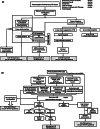Oral Granulomatous Disorders: A Diagnostic Insight
- PMID: 39211635
- PMCID: PMC11360674
- DOI: 10.7759/cureus.65742
Oral Granulomatous Disorders: A Diagnostic Insight
Abstract
Granulomatous inflammation represents a unique pattern of chronic inflammation observed in a restricted form of infectious and certain non-infectious diseases. The formation of granulomas typically involves immune responses. Granulomatous disorders encompass a broad spectrum of conditions that share the common histological feature of granuloma formation. Their involvement in the oral soft and hard tissues is quite infrequent; however, their manifestation can pose a diagnostic challenge due to the diverse range of potential causes and the relatively non-specific appearance of the individual lesions. The ultimate outcome of a complex entails the formation of a granuloma, resulting from the interplay among an invading pathogen or antigen, chemical substance, medication, or other irritant, persistent presence of antigens in the bloodstream, activation of macrophages, initiation of Th1 cell response, B-cell overactivity, presence of circulating immune complexes, and a wide range of biological signaling molecules, ultimately leading to the development of fibrosis attributed to the actions of transforming and platelet-derived growth factor. This article emphasizes the clinicopathological diagnostic criteria of oral granulomatous disorders as a guide for treatment and management.
Keywords: caseation necrosis; granuloma; inflammation; management; non-caseating.
Copyright © 2024, Roychowdhury et al.
Conflict of interest statement
Conflicts of interest: In compliance with the ICMJE uniform disclosure form, all authors declare the following: Payment/services info: All authors have declared that no financial support was received from any organization for the submitted work. Financial relationships: All authors have declared that they have no financial relationships at present or within the previous three years with any organizations that might have an interest in the submitted work. Other relationships: All authors have declared that there are no other relationships or activities that could appear to have influenced the submitted work.
Figures






















References
-
- Mohan H, Mohan S. JP Medical Ltd. JP Medical Ltd; 2012. Essential pathology for dental students.
-
- Kumar V, Abbas A. K, Fausto N, Aster J.C. Robbins and Cotran Pathologic Basis of Disease. Vol. 43. Elsevier Health Sciences; 2012. Robbins and Cotran pathologic basis of disease; p. 77.
-
- Granulomatous diseases of the oral tissues- an etiology & histopathology. Gotmare S, Tamgadge A, Bhalerao S, et al. 2007
-
- Macrophage structure | Britannica. 2024. https://www.britannica.com/science/macrophage https://www.britannica.com/science/macrophage
Publication types
LinkOut - more resources
Full Text Sources
